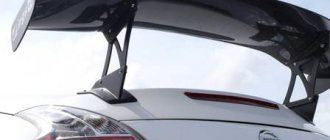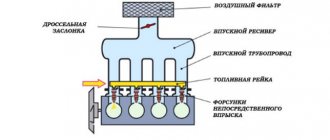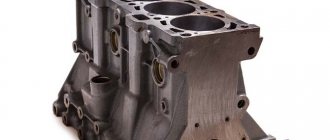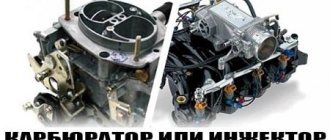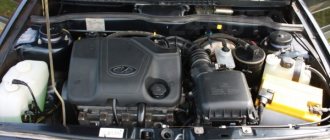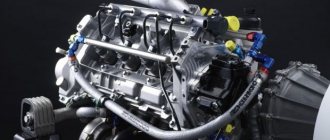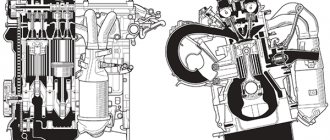The design and principle of operation of a boxer engine
The main distinguishing feature of a boxer engine is the arrangement of the pistons, the angle between which is 180°. That is, the movement of pairs of pistons in it occurs in a horizontal plane. Each pair has its own gas camshaft, which, together with the valves, unlike the usual in-line engine, are located horizontally. This type of engine is widely used in cars manufactured by the Volkswagen Group and SUBARU; they were equipped with the Soviet Ural and Dnepr motorcycles and the Ikarus bus.
The horizontal arrangement of the cylinders allows you to reduce vibrations, mutually compensating them, and achieve a smoother ride. As a result, the engine has the ability to smoothly increase power without noticeable jerks, and does not wear out so quickly. The boxer engine is located near the chassis of the car, which moves the center of gravity lower, thereby increasing the stability and controllability of the vehicle.
Boxer engines are available in petrol and diesel versions. In modern versions of such power units, to achieve maximum torque, economical fuel consumption and environmental friendliness, the following technical solutions are used:
- Reduced combustion chamber volume, increasing the compression ratio.
- The use of forging technology in the manufacture of piston group parts, which reduces their weight.
- Application of technologies for changing gas distribution phases.
- Using a new type of oil pump, thanks to which the engine is lubricated more efficiently.
- Structurally, a new cooling system has 2 circuits: a separate circuit of the cylinder block and its head.
Application area
Taking into account all the information considered, the presence of significant advantages and objective disadvantages, a natural question arises as to which cars can be found with a boxer engine.
It's fair to say that cars are not as often equipped with boxer engines as with traditional inline or V-twin powerplants.
But there is one automobile company that has been successfully and actively installing these types of engines on its models for more than fifty years. Moreover, it is largely thanks to this manufacturer that the development of the boxer engine segment is taking place. This is Subaru, which is based in Japan, but its cars are successfully sold all over the world.
But there are several more cars and vehicles that are equipped with such power plants. We are talking about the following vehicles:
- some models of the Volkswagen automaker;
- several cars from the Porsche brand;
- Soviet-style Ural motorcycles;
- Dnepr motorcycles;
- Ikarus buses coming from Hungary.
There is no need to talk about any global distribution of this type of engine. Although the sales volumes of the same Subaru cars with boxer power plants are impressive.
Recently, boxer engines have again attracted the attention of engineers and developers. Research and various tests are carried out regularly
Experts are striving to improve and modernize such engines. Moreover, a group of American specialists, whose work is funded by Bill Gates, is directly related to the development of OROS-type motors.
It’s difficult to say what will come of all this. But the fact of interest in opposition players hints to us that the problem of obvious shortcomings will soon be solved. In this case, in-line and V-shaped internal combustion engines will have a real and serious competitor. If the opposition gets rid of its shortcomings and retains its key advantages, this will allow it to take a huge step forward.
But so far everything is at the level of partial rumors, guesses and speculation. Whether it will really be possible to significantly change boxer engines in the near future is a difficult question.
Types of boxer engines
The boxer engine has been improved for more than 70 years since its inception, which led to the appearance of its following modifications:
1. Boxer is a proprietary Subaru development. It is distinguished by the equal distance of the pistons from each other: when one is located at TDC, the second is at the bottom.
2. OROS. For a long period it was not in demand, but recently the engine has been installed on cars and improved. The design uses one crankshaft, and each cylinder has 2 pistons working towards each other.
3. Tank TDF. Used on tanks developed in the USSR. This is a two-stroke engine, used only on military equipment.
Service
The most popular modern Subaru model is the Legacy. Let's consider the process of its maintenance.
The engine management system includes a self-diagnostic function. When a malfunction occurs, the Check Engine light comes on. When connecting the terminals in the connector under the steering column and then turning on the ignition, we find out the fault code, which can be deciphered using a Subaru car repair book.
Location of the piston group in a boxer engine.
If it turns out that there are too many errors, then the cause is improper repair.
- High-voltage wires are changed every 50 thousand km
- The service life of the camshaft timing belt is about 100 thousand km, after which it is recommended to replace it.
- The service life of the crankshaft and camshaft oil seals is 100 thousand km, after which they leak oil.
- Replacing the fuel filter is recommended every 10 thousand km.
- Fuel injectors are washed every 50 thousand km, but they are not removed from the engine.
Boxer engine: pros and cons
The main advantages of the boxer engine:
- Balanced operation and high efficiency. This is due to the horizontal arrangement of the pistons, when they provide counterweight to each other. The most efficient model of such an engine in terms of controllability and balance is considered to be a flat-six.
- Low center of gravity in the car, increasing its stability. This advantage is not very useful for a city car, but is very necessary for sports cars, for which stability at high speed is vital.
- High reliability and durability. Most of the boxer engines are capable of operating for 500 thousand km before overhaul, which is much longer than the service life of the engines of many budget cars, including Volkswagen.
- Compliance with high standards of passive safety. In the event of a frontal collision, such an engine moves down without causing harm to passengers and the driver.
Weaknesses of Opposites:
- Design features of the unit that make repairs too expensive. To service such an engine, a highly professional technician is required, as well as the use of special equipment.
- The large dimensions of the engine allow it to be installed only in the longitudinal direction.
- High oil consumption due to the complexity of the design.
Some features of modern boxers
Since its development and installation of the first boxer engine in a Volkswagen in 1938, this type of engine has undergone major modernization. Four-cylinder engines are currently the most widespread - they are the most environmentally friendly, compact and economical in terms of fuel consumption. In many ways, this was the result of many years of painstaking work by engineers who implemented a sufficient number of unique developments in such motors:
- increased compression ratio, while the chamber itself is smaller in size and the piston stroke is increased;
- innovative gas distribution system;
- the total mass of all moving elements has decreased significantly;
- a forced lubrication system operating with a separate pump, which ensures a constant and high-quality supply of oil to the necessary components;
- a fundamentally new cooling system that virtually eliminates the possibility of accidental overheating of the engine.
The high reliability and power of the boxer engine is evidenced by the fact that this particular type of engine was installed on the Soviet T-64 tank, and later on the T-72. Only such a boxer engine, the operating principle of which has changed little since then, was able to provide high power with its relatively small overall dimensions. For reference, only it could produce about seven hundred horsepower at 2 thousand revolutions and a volume of 13.6 liters. You can learn a lot of interesting facts about the operation of opposition motors by watching the video:
Difficulties in repairing and servicing a boxer engine
All the advantages of the boxer engine are fully revealed in the six-cylinder version. Units with fewer cylinders have almost the same characteristics as traditional ones. The main problem for the owner of a boxer car will be the difficulty of maintenance due to the horizontal arrangement of the cylinder and the small free space under the hood for this reason.
The driver can independently change the oil in it, and other types of work can only be done at an auto center. Thus, a simple replacement of spark plugs should be carried out by a qualified specialist, but a beginner, performing this operation on his own, can damage the cylinder head. In the event of a malfunction, such an engine should also be repaired at a specialized service station.
The only thing that can be successfully done on your own is to fight carbon deposits on the parts of the piston group and combustion chamber, which is formed when using low-quality fuel, driving without load and on a cold engine. To do this, a carbon removal technique called decarbonization is used, which is divided into soft and hard. If it is hard, pour a softening liquid through the hole from the inverted spark plug for 12 hours to destroy the carbon deposits.
This method is not suitable for a boxer engine, since unscrewing the spark plugs in it is a rather problematic procedure and requires skills and special tools. But you can use gentle cleaning in the form of a special cleaning additive for the oil. A mileage of 200 km will be enough for it to work, after which the oil in the power unit must be replaced.
If your Subaru's automatic transmission kicks, this does not always mean an expensive repair.
Description
The element that makes the boxer engine very different from its counterparts is the placement of the pistons of the unit. The concept included in the name of the motor assumes the presence of an angle equal to one hundred and eighty degrees, this is how the pistons are located. The process of operation of the pistons is accompanied by the same position that they occupy relative to each other in the cylinder. However, the camber angle is not an argument, since a similar angle value is inherent in the pistons of the unit with camber in the form of the letter “V”. In this engine, the pistons and connecting rods are attached to the same connecting rod journal, so that the movement of one of the pistons to its highest position is accompanied by the movement of the other to its lowest position.
Structurally, in a boxer engine, each piston and each connecting rod are located on a separate crankpin of the crankshaft. This type of engine is more complex than an inline or v-twin engine, since there are more parts and adjustments are more difficult. Thus, the boxer engine, due to its design, is equipped with two cylinder heads. In turn, the heads are equipped with gaskets and a manifold, which increases the number of elements. Don’t forget about the circuit used to activate the camshaft and set up the mechanisms.
Given the design features, companies do not launch the unit en masse. Among the proven ones: the boxer engine of Porsche, Volkswagen, Subaru. The layout of the opposed units allows them to operate with less vibration, smooth running, and reduced wear of parts. The result is obtained due to the mutual movement of the pistons in opposite directions and the balancing of the resulting forces. The horizontal location of the power plant increases the vehicle's stability.
Boxer engine cross-section:
Prospects for the use of boxer engines
The most famous automakers that use a boxer engine in their models are Porsche and Subaru. The first is experiencing its heyday, while the second is not having its best times. This is due to the targeting of products at different target audiences: in the first case, Porsche cars are positioned as elite products, implying high technology and maintenance costs, and in the second, middle-class cars for those who like to have racing technologies on an ordinary car.
Customers are willing to pay quite large sums of money for a Porsche, but for a car with an engine slightly exceeding 100 hp in power. s., which after a run of 130 thousand km. expensive repairs will be required, especially if it is turbocharged, only the most loyal customers can give preference. But given the fact that many funds and developers are improving boxer engines, as well as the fact that they are also used in motorcycles, one can remain confident that boxer engines will be relevant for a long time.
Operating problems through the eyes of a car owner
Let's look at what problems arise during operation using the example of the most common cars with opposed internal combustion engines - Subaru. Thus, owners note the difficulty of selecting spare parts. The same series of engines may have different types of block and cylinder head. The channels, timing valves and the shape of the camshaft cams are also different, so the selection of spare parts for repairs should be approached responsibly. Most parts are purchased to order, car owners note.
The service life of opposed internal combustion engines in practice differs significantly. Yes, most engines are “killed” in the early stages due to illiterate tuning, but even without modifications you can suddenly end up in need of repairs. A common problem with boxer engines is uneven lubrication on the mirror/honor of the cylinders due to their horizontal location. But that's not so bad. In the struggle for relief, manufacturers shorten the already small piston skirts, which provokes scuffing and subsequent knocking.
Scratches on the cylinder wall
For Subaru cars this is the knock of 2 and 4 pistons. But it’s worth talking about really resourceful ones - there are a number of examples where a knocking engine worked for more than 30-50 thousand kilometers before overhaul. This is a big plus for those who are looking for reliable cars.
Along with short pistons, manufacturers began to use thinner rings. Because of this, oil consumption has increased slightly, according to the owners.
Another “pain” for owners of boxer engines is grinding the crankshaft journal. The peculiarity is that this work cannot be performed on a machine for conventional units due to the narrow dimensions of the necks. This leads to difficulties in finding a repairman and the corresponding amount of repairs.
Owners of EJ25 engines should carefully monitor the engine temperature - the manufacturer made a small cooling jacket and increased the diameter of the liners in the block.
Even with slight overheating, there is a tendency for the block and head to deform. When the mileage is above 150 thousand kilometers, it is worth monitoring not only the oil level, but also the antifreeze level. Due to the thin liners and the small area of their contact with the gasket, the coolant went into the cylinders.
Boxer turbocharged engines before 2000 had problems with the ECU configuration. The unit did not respond correctly to the octane number of gasoline and the ambient temperature. High boost pressure destroyed the engine.
On the same turbocharged EJ25, after 100 thousand kilometers it was necessary to change the liners (due to high loads on the narrow necks and lack of lubrication in the contact patch). Fortunately, the manufacturer offers sets of new liners with repair sizes up to +0.50.
Varieties
In many ways, the operating principle and some design features depend on the specific type of boxer power unit.
There are several main categories of horizontally opposed engines:
- boxers;
- OROS;
- tank engines.
Boxers are widely used in passenger cars. The main user of such engines is the Japanese auto company Subaru.
In such a boxer engine, the pistons are located at a certain distance relative to each other and stand opposite. If the first piston is fixed at a certain distance from the motor axis, then the second one will occupy the same similar position. In this case, in the engine, each piston is placed in its own separate cylinder. By visualizing the operation of such a motor, one can imagine a fight between two boxers. Hence the corresponding name.
As for other engines of the OROS type, the design principle and the order of operation carried out by the pistons are somewhat different. These are two-stroke power units. One cylinder has 2 pistons at once, mounted on one crankshaft. In this case, the first is responsible for the intake of the working air-fuel mixture, while the second promptly removes the resulting combustion products.
A feature of OROS engines is the absence of a head, which is usually installed on the cylinder block. The advantage of such a unit is that the pistons operate on only one crankshaft. The boxer is small in size, requires less space and has a low weight. This made it possible to use the motor in different areas and on different vehicles.
OROS can operate on two types of fuel, that is, diesel and gasoline. Its advantages also include:
- When performing their work, the pistons travel a slightly shorter distance, which significantly reduces the friction force and minimizes wear;
- increased efficiency, which is due to the absence of harmful effects of exhaust gases on the combustion chamber. They exert pressure on the working pistons;
- when compared with classic engines, the mass of the OROS will be 30-50% less;
- This type of boxer engine uses fewer elements. When compared with in-line and V-shaped ones, the difference will be 40-50% on average;
- such power units are quite economical;
- The design does not use a valve drive system;
- Less space is required to place the installation in the engine compartment of a car.
But not everything is as rosy as it may seem at first. This type of engine is under development and gradual improvement. It is too early to talk about any real and global successes, since there are a number of hidden and unforeseen problems that arise during operation.
Now regarding the third type of boxer engine, which is called a tank engine. This is a power plant labeled 5TDF. The motor was created specifically for tanks of the T-64 and T-72 series.
Tank engine 5TDF
The opposition tank has an impressive service life, since it was originally designed for installation in large military equipment. The pistons share a single cylinder and move in the same direction, although each has its own separate crankshaft.
The place for ignition of the air-fuel mixture is created by creating a minimum gap or gap between two installed working pistons. As in the case of OROS, here air enters the cylinders, and exhaust gases exit due to the operation of the turbocharging system.
Due to the counter-movement of the working pistons, the engineers managed to create a power unit that was compact in size but impressive in its power. The maximum number of revolutions for a boxer tank reaches 2 thousand. The power of the unit is 700 horsepower. The engine displacement can be 6 or 13 liters.
The boxer tank can operate on gasoline and diesel fuel. This is a domestic development, which at one time managed to make an impression. But at present TDF is no longer produced.
Advantages and disadvantages
To fully reveal the features of this motor, you need to look at its strengths and weaknesses.
Let's start with the most relevant advantages of boxer engines. Its advantages include the following points:
- What's really good about the boxer engine is the best layout variation. The engine is always located low, which is much better than classic internal combustion engines. This allows for a lower center of gravity. This improves stability and controllability,
- The boxer is also the best among its competitors due to its being virtually on the same level with the transmission. This feature makes it possible to minimize losses during torque transmission,
- A strong argument in favor of a boxer engine is the minimal level of vibration even when the car is moving at maximum speeds. This advantage is explained by the location of the cylinder-piston group. In this way, the engineers created the perfect balance and were able to guarantee effective damping of all potential vibrations. This makes the engine run smoothly, there are no jerks,
- design features and balance made it possible to use not 5, but only 3 bearings for the crankshaft. Due to this, it became shorter and lighter,
- Among all its competitors, the boxer is the undisputed leader in terms of ensuring passive safety. Even in the event of a strong frontal collision, the engine will not penetrate inside the cabin. When struck, it simply falls without causing damage to the driver or passengers. This feature managed to save more than one thousand lives,
- If you properly maintain a boxer engine, regardless of the type of fuel used, the boxer engine will be able to boast a huge resource. With proper care, such an engine lasts about 1 million kilometers. To achieve this result, you just need to change the oil and other consumables on time, and also not subject the unit to excessive extreme loads.
Although the list of advantages turned out to be impressive, the boxer engine also has its significant disadvantages. And these disadvantages can largely cover all the existing advantages.
Expensive self-service. The owner of a car with a boxer engine will be able to perform only a number of simple procedures during the maintenance process. Most of the work will have to be carried out with the involvement of specialists. And these are additional costs for maintaining the vehicle. Expensive and difficult repairs. The complexity of repairs provokes an increase in the cost of services. The spare parts for boxer engines themselves are quite expensive. Plus you have to look for competent specialists. There are very few professionals in the field of boxer engines. And those who work with such power plants ask quite a lot of money for their services. Complex design. To perform certain work and change some consumables, sometimes you have to partially disassemble the engine. This is problematic and inaccessible for an inexperienced motorist. Conditional compactness. Although such engines were made small and placed low, they still require quite a lot of space under the hood. Active oil consumption
In boxer engines, it is extremely important to monitor not only the condition, but also the amount of oil. The motor has a good appetite for lubricant
If starvation begins, it will lead to extremely negative, serious and expensive consequences. Removable cylinder liners. The fact that they are removable is a positive thing. But to replace the liners, you have to carry out a number of complex measures to partially disassemble the engine. If this is not done, the engine will soon begin to consume oil even more actively, which will ultimately lead to rapid failure of the entire boxer engine. There is an acute shortage of qualified craftsmen. For Russia and the CIS countries this is one of the main problems. Many people would be happy to buy a car with a boxer engine. But a large number of questions are raised by the fact that there are no good craftsmen. There are those who take on servicing opposition players, but the quality of their work leaves much to be desired. Qualified craftsmen are expensive, and they do not work in every city.
Boxer engines can be called internal combustion engines with excellent capabilities and bright prospects. There is still room for improvement. Therefore, automakers who are really interested in boxer engines are constantly trying to come up with something new, introduce fresh ideas and fight against objective shortcomings.

